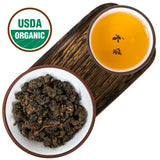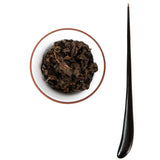Wandering Lao Cha reached the Chiang Rai Mountains in Thailand. There, he has exchanged knowledge of tea with the local Chinese community. At a meeting, the locals presented him with a unique GABA tea. The tea had the smell and taste of wild berries, plum jam, and honey oats – unusual for oolongs.
After trying this tea, Lao Cha felt he entered a meditative state of complete presence and inner balance, even as the discussion was heated and emotional.
- Dear brothers, what is this tea? - Lao Cha asked the local farmers.
- This is the good old Ruan Zhi that we brought from Taiwan, planted in the local fertile soil, and processed as GABA tea.
This is how tea reminded the all-wise Lao Cha that in the endless world under Heaven, something new is always sprouting from something well-known.
If you haven't heard the buzz yet, you may ask: What is GABA tea? Furthermore, what is GABA? GABA is Gamma-Aminobutyric acid, a neurotransmitter responsible for regulating muscle tone, calming nerves, improving sleep, and balancing moods. It is naturally present in our bodies. And GABA is also naturally present in tea! All teas contain GABA, though in small amounts that don't play a significant role.
In the 1980s, Japanese scientists found that letting tea ferment from 6 to 10 hours in a nitrogen-rich / oxygen-free environment results in GABA in the tea leaves rising ten times higher than the original. Although it remains inconclusive whether GABA, when taken orally, can cross the blood-to-brain barrier (BBB), many people claim that GABA tea helps them achieve clarity and a peaceful state of being. In terms of taste, GABA translates into a pleasant sourness.
Thai Oolongs are descendants of Taiwanese cultivars. And Thai farmers are of Chinese origin. Their parents fled the Revolution. They settled in Thailand, and today, their descendants produce oolongs on the slopes of the Thai mountains. Tea trees are very demanding and require a lot of water and minerals. The cultivation of tea in Thailand started relatively recently. Furthermore, unlike in some areas of China and Taiwan, the land allotted to plantations is fertile and not yet depleted.
This tea comes from one of the oldest oolong gardens in Chiang Rai province. The founder of this tea garden is no longer alive. However, he developed his own farming technique and passed it on to his daughters – the makers of this stunning tea. This lightly roasted oolong has a complex, unique aroma and taste, with notes of raspberry, green pear, plum jam, and honey oats.
This high mountain oolong is USDA-certified organic. At the plantation, tea grows together with daisies and other weeds. Additionally, cows roam freely to graze – tea leaves are too bitter for them, while wildflowers and weeds are an excellent source of food. That's the Thai way of cow-working;)

Weeding out.
- Place of Origin: Chiang Rai, Thailand
- Altitude: 1200m
- Harvest Date: May 2025
- Picking Standard: One bud and two or three leaves
- Roast Level: Light
- Aroma: Berries & honey oats
- Taste: Sweet & sour, with raspberry, pear, and plum-jam notes
- Cultivar: Ruan Zhi (aka Qing Xin / TRES#17)
Brewing guidelines:
![]() 205℉ / 95℃
205℉ / 95℃
 1g per 70-100ml
1g per 70-100ml ![]() 3-4min
3-4min
 1g per 20ml
1g per 20ml ![]() 10sec + 5sec for each subsequent infusion
10sec + 5sec for each subsequent infusion





